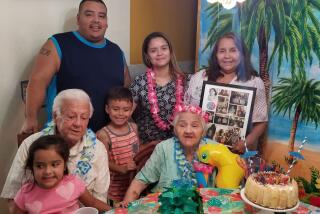Latinos are more at risk for some eye diseases
- Share via
Juana Durazo didn’t know she was slowly going blind.
The 62-year-old had been getting routine eye exams for years, but her diabetic retinopathy -- a progressive eye disease associated with diabetes -- had gone undetected.
Only when she enrolled in USC’s Latino Eye Study and received a more extensive eye exam was the condition diagnosed.
That study, results of which were published in the June, July and August issues of Ophthalmology, established for the first time that older Latinos are more likely than whites of the same age to have certain eye diseases that lead to blindness.
It also found that, like Durazo, most lack awareness about the diseases. In the study, 6,357 residents of La Puente, a predominantly Latino city in Los Angeles County, were given comprehensive eye examinations that lasted two to three hours.
Three-fourths of study participants diagnosed with open-angle glaucoma did not know they had the disease, said principal investigator Dr. Rohit Varma.
The condition, which puts pressure on the eye’s optic nerve, has nearly no symptoms and can be detected only through a comprehensive eye exam, Varma said.
“This is not something which is iffy. These people had a real disease and they had a treatable disease,” Varma said. “The fact that less than one-quarter of them knew is a big problem.”
The only way to detect open-angle glaucoma is through a comprehensive eye exam that takes longer than the routine eye exam people usually get, Varma said. “It’s like a silent killer of eyesight ... you don’t know you’ve had it until it’s gone too far.”
According to the study, 4.74%of Latinos, age 40 and older have open-angle glaucoma, compared with 4.97% of African Americans and 1.44% of whites in that age group.
The study also found that on average 42.6% of Latinos have some form of diabetic retinopathy, the leading cause of new blindness in the U.S., compared with 35.2% of whites and 26.5% of African Americans found in other studies. Also, one out of four people in the study had diabetes, a fifth of whom had not been diagnosed.
About half of all the diabetic patients also had diabetic retinopathy.
Durazo said her sister and cousin, both of whom have diabetes, also were unaware they had diabetic retinopathy until they were diagnosed through the extensive eye exam.
“We know for a fact that many Latinos don’t get the care recommended by the Diabetes Assn.,” said Varma who speculates that the high rates of diabetic retinopathy have to do with the rise in Type 2 diabetes among Latinos and barriers they face to adequate care.
However, he said, Type 2 diabetes and diabetic retinopathy are preventable and treatable if detected. “What this suggests is that targeted programs need to be developed for targeted screening and treatment ... because [Latinos] are the fastest growing sector of the population,” Varma said.






